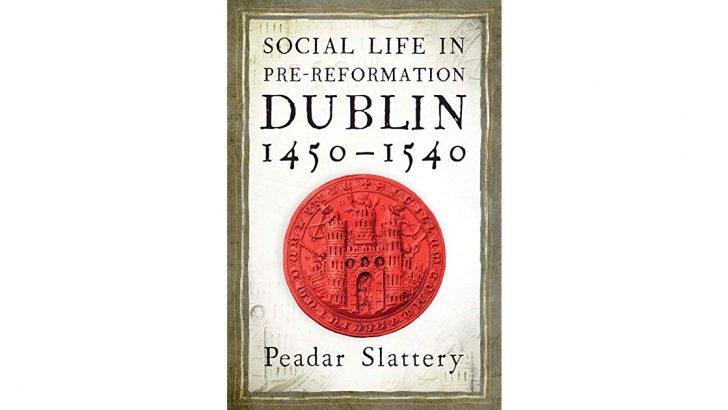Social Life in Pre-Reformation Dublin 1450-1540
by Peadar Slattery (Four Courts Press, €45.00)
Recently I was involved, in quite another capacity, in raising money for the purchase for the Trinity College Research collections of a fugitive manuscript from St Mary’s Abbey in Dublin, liquidated at the time of the Reformation.
This brought to my attention how little we know about the intellectual and literary culture of the city of Dublin in the Middle Ages. War, disasters, wanton crimes have afflicted the survival of records. Literature, as we know it, only began in Dublin after the Restoration.
It is because the intellectual records of Dublin for the Middle Ages have been destroyed , that what can be cleaned is to important. In this fascinating book, which covers in detail the life of the city in the century before the Reformation, we are given glimpse of a city which was lively, wealthy, well connected, but with which we now have only the most fragile of connections. Though Irish records are meagre in many ways, very detailed information can be culled from archives in Britain and elsewhere, which show the true state of things in Dublin.
Trade
The essential fact was that this was an English city, heavily involved with Chester and with Bristol. So this book is able to reveal an astonishing amount about life in Dublin, especially relating to commerce, trade and its related activities such as guilds and apprentices.
The chapter on provisioning the city is especially interesting, revealing jut how important connections with Britain and with Europe were – this is a sort of deep background to the whole matter of Brexit perhaps – showing just how important trade has been in the past in creating a culture.
However for readers of these pages two chapters later in the book dealing with the traditional church, that had developed over the course of the middle ages, and with the movements for change and reform that grew up in the 15th Century leading on to the Reformation. Especially interesting is the important role played by the laity in the actual running of the Church at a parish and city level.
But returning to the matter of culture a very short chapter deals with the presentation of dramas, the miracle plays familiar from Chester and elsewhere (such as the famous Everyman). These were the special province of various guilds, but they were mounted not only for the good of the citizen’s souls but for their entertainment.
In these street shows Dublin’s great theatrical tradition had its beginnings.
Very detailed information can be culled…which show the true state of things in Dublin”
The final chapter deals with continuity and religious revolution, but this inevitably has to be less detailed, less human that the earlier chapters, simply because one is moving into a new era and new forces rather than the famialr traditions of the middle ages were forming and reforming opinion.
Altogether this book, the result of many years of assiduous personal research, both among the archives, the books and journals, but also out in the field photographing surviving medieval chapels and churches, provides a fascinating panorama of a whole age.
Clearly there is more to be learned about ordinary life as well as the intellectual and artistic life of the city. But it demonstrates many factors that would continued to affected urban life down to our own times. Later scholars were largely interested in rural and not urban life in Ireland.
Dublin was seen by many as something alien and of no account. This book reveals in great detail what was there. It will be a revelation for every historically minded Dubliner.


 Peter Costello
Peter Costello Photo: Good reads
Photo: Good reads 